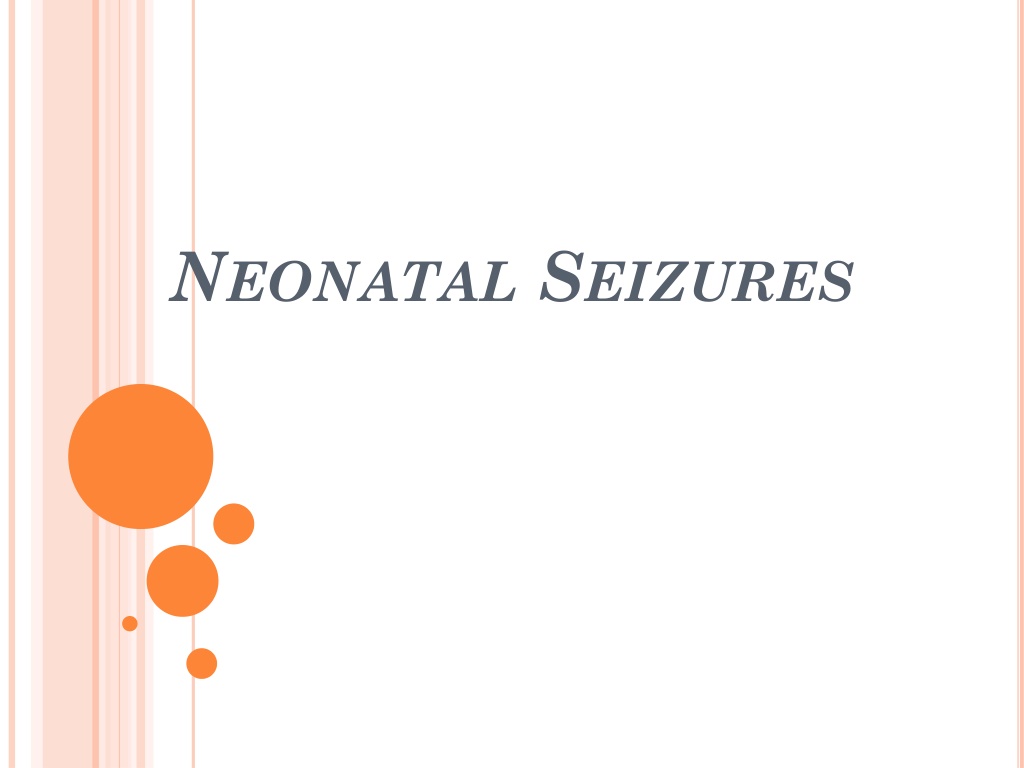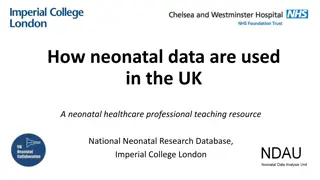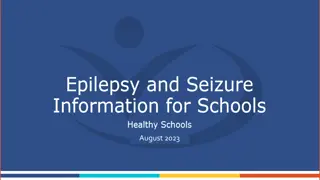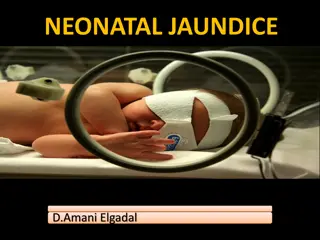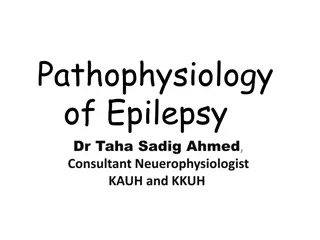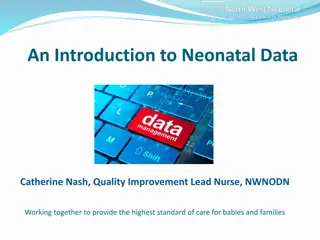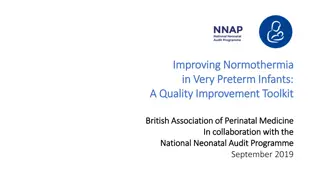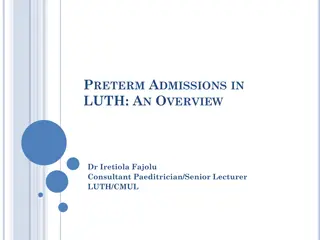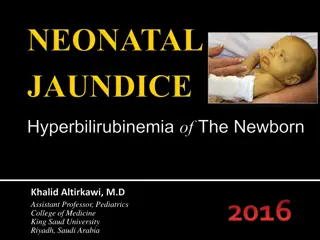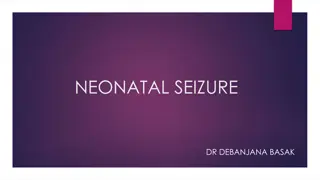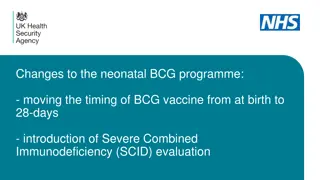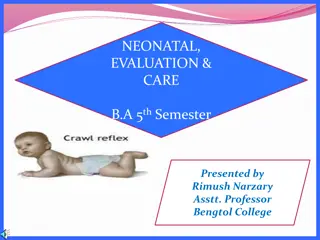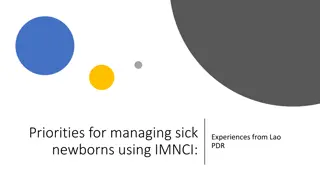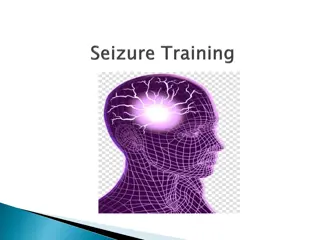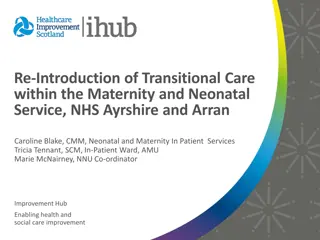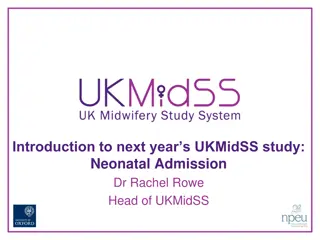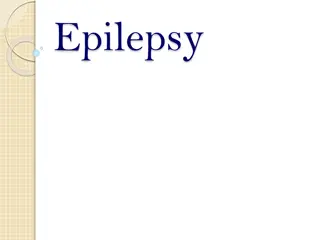Understanding Neonatal Seizures and Differentiating from Jitteriness
Neonatal seizures are a critical sign of neurologic dysfunction in newborns, with various types such as subtle, clonic, tonic, spasms, and myoclonic seizures. The immature brain's excitability and differences from the mature brain predispose neonates to seizures. Generalized clonic seizures are rare due to incomplete myelination. Recognizing different seizure types is crucial in neonatal care to differentiate from benign conditions like jitteriness.
Download Presentation

Please find below an Image/Link to download the presentation.
The content on the website is provided AS IS for your information and personal use only. It may not be sold, licensed, or shared on other websites without obtaining consent from the author. Download presentation by click this link. If you encounter any issues during the download, it is possible that the publisher has removed the file from their server.
E N D
Presentation Transcript
Seizures are possibly the most important and common indicator of significant neurologic dysfunction in the neonatal period. Seizure incidence is higher during this period than in any other period in life immature brain has many differences from the mature brain that render it more excitable and more likely to develop seizures
Generalized clonic seizures that are bilateral, symmetric, and synchronous are uncommon in the neonatal period presumably due to decreased connectivity associated with incomplete myelination at this age.
TYPES OF NEONATAL SEIZURES Subtle Seizures :Subtle seizures include transient eye deviations, nystagmus, blinking, mouthing, abnormal extremity movements (rowing, swimming, bicycling, pedaling, and stepping), fluctuations in heart rate, hypertension episodes, and apnea
Clonic Seizures Clonic seizures consists of jerky movements of extremities can be focal or multifocal. Multifocal clonic seizures incorporate several body parts and are migratory in nature
Tonic Seizures :seizures can be focal or generalized (generalized are more common). Focal tonic seizures include persistent posturing of a limb or posturing of trunk or neck in an asymmetric way often with persistent horizontal eye deviation. Generalized tonic seizures are bilateral tonic limb extension or tonic flexion of upper extremities often associated with tonic extension of lower extremities.
Spasms: Spasms are sudden generalized jerks lasting 1-2 sec that are distinguished from generalized tonic spells by their shorter duration. Myoclonic Seizures :Myoclonic seizures are divided into focal, multifocal, and generalized types. Myoclonic seizures can be distinguished from clonic seizures by the rapidity of the jerks (<50 msec) and by their lack of rhythmicity
SEIZURES VS JITTERINESS Jitteriness can be defined as rapid motor activities, such as a tremor or shake, that can be ended by flexion or holding the limb. Seizures, on the other hand, generally do not end with tactile or motor suppression. Jitteriness, unlike most seizures, is usually induced by a stimulus. Also unlike jitteriness, seizures often involve eye deviation and autonomic changes.
CAUSES OF NEONATAL SEIZURES Hypoxic Ischemic Encephalopathy :This is the most common cause of neonatal seizures Intracranial Infections Bacterial and nonbacterial infections account for 5-10% of the cases of neonatal seizures and include bacterial meningitis, TORCH (toxoplasmosis, other infections, rubella, cytomegalovirus, herpes simplex virus) infections, particularly herpes simplex encephalitis.
Vascular Events :These include intracranial bleeds and ischemic strokes Brain Malformations Metabolic Disturbances: -Hypoglycemia can cause neurologic disturbances and is very common in small neonates and neonates whose mothers are diabetic -Hypocalcemia, Hypomagnesemia , Hyponatremia Local anesthetic intoxication seizures can result from neonatal intoxication with local anesthetics administered into the infant s scalp
Neonatal seizures can also result from disturbances in amino acid or organic acid metabolism Pyridoxine and pyridoxal dependency disorders can cause severe seizures Drug Withdrawal Seizures can rarely be caused by the neonate s passive addiction and then drug withdrawal. Such drugs include narcotic analgesics, sedative hypnotics, and others Neonatal Seizure Syndromes include benign idiopathic neonatal seizures (fifth day fits), Autosomal dominant benign familial neonatal seizures(treat. for 6-12mns)
DIAGNOSIS: Some cases can be correctly diagnosed by simply taking the prenatal and postnatal history and performing an adequate physical examination. Depending on the case, additional tests or procedures can be performed Blood should be obtained for determinations of glucose, calcium, magnesium, electrolytes, and blood urea nitrogen lumbar puncture is indicated in virtually all neonates with seizures, unless the cause is obviously related to a metabolic disorder such as hypoglycemia or hypocalcemia. EEG is considered the main tool for diagnosis, MRI.
TREATMENT : A mainstay in the therapy of neonatal seizures is the diagnosis and treatment of the underlying etiology (e.g., hypoglycemia, hypocalcemia, meningitis, drug withdrawal, trauma) Lorazepam: The initial drug used to control acute seizures is usually lorazepam. Lorazepam is distributed to the brain very quickly Diazepam Diazepam can be used as an alternative initial drug, The usual dose is 0.1-0.3 mg/kg IV over 3-5 min, However, because of the respiratory and blood pressure limitations, it is currently not recommended as a first-line agent.
Phenobarbital: Phenobarbital is considered by many as the first choice long-acting drug in neonatal seizures, The usual loading dose is 20 mg/kg, maintenance dosing can be started at 3-6 mg/kg/ day usually administered in 2 separate doses. Phenytoin and Fosphenytoin: For ongoing seizures, if a total loading dose of 40 mg/kg of phenobarbital was not effective, then a loading dose of 15-20 mg/kg of phenytoin can be administered intravenously, Maintenance doses of 4-8mg/kg.
DURATION OF THERAPY Duration of therapy is related to the risk of developing later epilepsy in infants suffering from neonatal seizures, which ranges from 10- 30% and depends on the individual neurologic examination, the etiology of the seizures, and the EEG at the time of discharge from the hospital. In general, if the EEG at the time of discharge does not show evidence of epileptiform activity, then medications are usually tapered at that time. If the EEG remains paroxysmal, then the decision is usually delayed for several months after discharge
PROGNOSIS The correlation between EEG and prognosis is very clear. Although neonatal EEG interpretation is very difficult. An abnormal background is a powerful predictor of less- favorable later outcome The underlying etiology of the seizures is the main determinant of outcome. For example, patients with seizures secondary to hypoxic ischemic encephalopathy have a 50% chance of developing normally, whereas those with seizures caused by primary subarachnoid hemorrhage or hypocalcemia have a much better prognosis.
